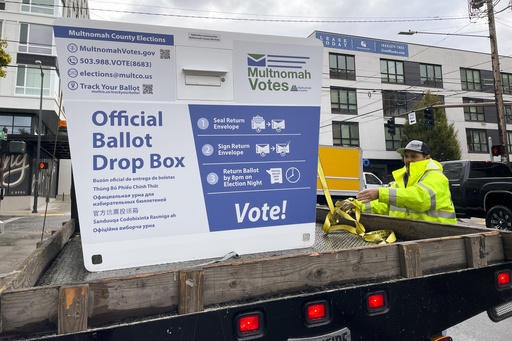
ATLANTA – Recently, two ballot drop boxes in the Pacific Northwest experienced damage from what appears to be arson, occurring just over a week ahead of Election Day. One incident took place in Vancouver, Washington, where numerous ballots were destroyed, while the other occurred in Portland, Oregon, where a fire suppression system minimized damage to just three ballots. Law enforcement is currently examining surveillance video in hopes of pinpointing the individuals responsible for these acts.
The fires at the drop boxes are believed to have been ignited using incendiary devices. Authorities have indicated that there’s evidence linking these incidents to a previous event on October 8, where another incendiary device was detected at a separate drop box in Vancouver. Tim Scott, the Elections Director for Multnomah County, shared plans to reach out to the voters affected by the fire in Portland to assist them in obtaining replacement ballots. In contrast, hundreds of ballots were lost at the Fisher’s Landing Transit Center in Vancouver because the fire suppression system failed to operate effectively. Clark County Auditor Greg Kimsey disclosed that the drop box was emptied earlier that day at 11 a.m., and voters who submitted their ballots afterward are being encouraged to get in touch with the election office for replacements. To enhance security, their team will be increasing the frequency of ballot collections and will change collection times to the evening to deter potential vandalism.
Kimsey has described the suspected arson as “a direct attack on democracy.” Ballot drop boxes have been a part of the voting process in states like Colorado, Oregon, Utah, and Washington for many years, allowing ballots to be mailed to all registered voters. Their use surged in popularity during the 2020 COVID-19 pandemic, as election officials aimed to provide safe voting options for those who sought alternatives to crowded polling locations and were concerned about potential mail delays. A comprehensive study from the National Conference of State Legislatures identifies that 27 states and the District of Columbia permit ballot drop boxes, while six states lack specific laws but allow for variations at the local level.
The locations of these drop boxes differ significantly across states and communities, with some found inside public buildings during business hours, while others are placed outside for round-the-clock access, often under surveillance. Instances of problems related to drop boxes have emerged, including some being damaged by vehicles or arson attacks. In one notable case in Massachusetts in 2020, most ballots were deemed adequately intact to allow voters to be identified for replacements following a similar incident. Another similar event occurred in Los Angeles County that same year.
In light of these incidents, the U.S. Cybersecurity and Infrastructure Security Agency has advised election officials on secure practices for drop boxes, recommending they be placed in familiar, high-traffic areas such as libraries and community centers. If these drop boxes are unattended, they should remain locked, be placed in well-lit areas, and be monitored via cameras. Many drop boxes are affixed securely, ensured to be under surveillance, or housed within public buildings during operational hours.
Ballot drop boxes have faced heightened scrutiny since the last presidential election, with right-wing conspiracy theories claiming they were instrumental in significant voter fraud. A widely regarded false documentary titled “2,000 Mules” spread erroneous assertions about alleged secretive operations to deposit fake ballots in drop boxes. An investigation revealed no widespread issues pertaining to drop boxes during the 2020 elections, according to a survey of state election officials.
As these conspiracy theories continued, the 2022 midterms saw armed individuals monitoring drop boxes in places like Arizona, leading to federal intervention. The conservative group True the Vote even initiated a website to document real-time views of drop boxes in various states. In Montana, during a crucial U.S. Senate race, Republicans highlighted unverified claims of food box tampering to exploit doubts surrounding the electoral process.
In response to these situations since the 2020 election, various Republican lawmakers have aimed to tighten voting regulations, particularly focusing on ballot drop boxes. Research from the Voting Rights Lab indicates that six states have banned these drop boxes entirely, including Arkansas, Mississippi, Missouri, North Carolina, South Carolina, and South Dakota. Other states, such as Ohio and Iowa, have restricted their use to only one drop box per county.
Georgia’s Fulton County, home to over a million residents in Atlanta, has dramatically reduced the available drop boxes from 38 to just 10 for this year’s presidential election due to an election reform initiative following claims of electoral fraud from former President Trump. Overall, twelve states currently prohibit or do not recognize drop boxes as an acceptable means for returning ballots. Additionally, five states lack both state laws and do not implement drop box systems.
Ballot drop boxes, traditionally utilized in Wisconsin—another pivotal battleground this year—have become a point of division along ideological lines since 2020. Recently, in Wausau, conservative officials interfered with the city’s sole drop box, an action now under investigation. Fortunately, the drop box has since been reinstated and is operational once again.
